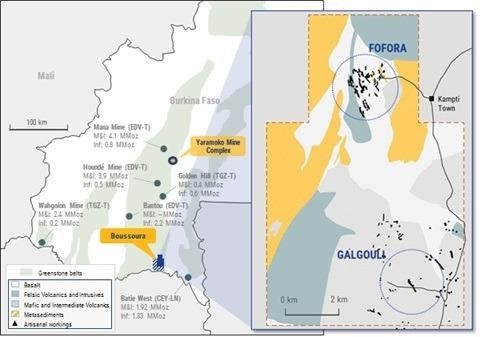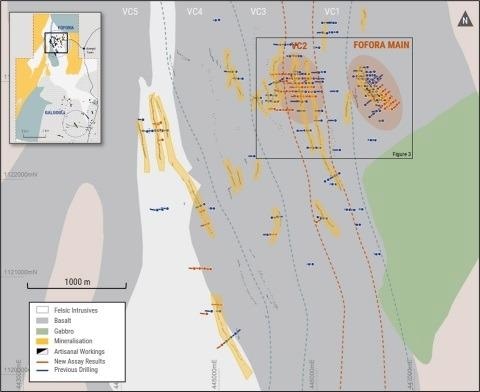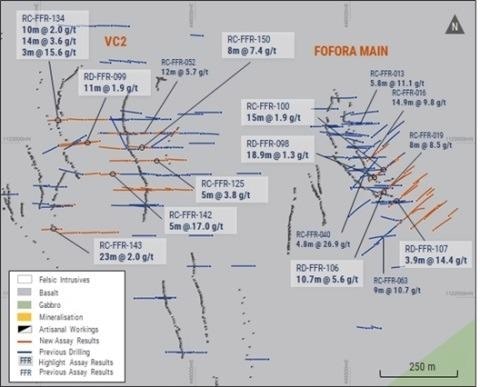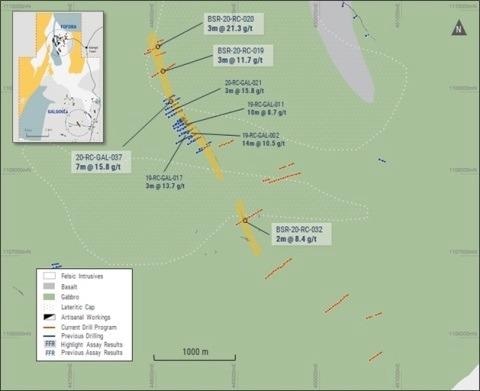Feb 2 2021
Roxgold Inc. (“Roxgold” or the “Company”) is pleased to announce new exploration drilling results from the Company’s Boussoura Project, located on the Houndé Greenstone Belt in southern Burkina Faso.
 Figure 1. Boussoura Project Location on Houndé Belt
Figure 1. Boussoura Project Location on Houndé Belt
Boussoura Project, Burkina Faso
Highlights from scout Reverse Circulation (“RC”) and Diamond Core (“RD”) drilling
Fofora – Fofora Main
- 10.7 m at 5.6 g/t Au in drill hole BSR-20-RD-FFR-106 from 103 m including
- 1 m at 27.4 g/t Au from 103 m
- 3.9 m at 14.4 g/t Au in drill hole BSR-20-RD-FFR-107 from 96.4 m including
- 1 m at 52.3 g/t Au from 97.8 m
- 15.0 m at 1.9 g/t Au in drill hole BSR-20-RC-FFR-100 from 82 m
- 18.9 m at 1.3 g/t Auin drill hole BSR-20-RC-FFR-98 from 112 m
Fofora – VC2
- 5 m at 17.0 g/t Au in drill hole BSR-20-RC-FFR-142 from 59 m including
- 2 m at 40.9 g/t Au from 60 m
- 8 m at 7.4 g/t Au in drill hole BSR-20-RC-FFR-150 from 100 m including
- 1 m at 48.9 g/t Au from 105m
- 10 m at 2.0 g/t Au in drill hole BSR-20-RC-FFR-134 from 28 m, followed by separate intervals of:
- 14 m at 3.6 g/t Au from 44 m, and
- 3 m at 15.6 g/t Au from 79 m
- 23 m at 2.0 g/t Au in drill hole BSR-20-RC-FFR-143 from 41 m
- 19.4 m at 1.1 g/t Au in drill hole BSR-20-RD-FFR-120 from 55.4 m, followed by a separate interval of:
- 5.4 m at 5.4 g/t Au from 166 m
Galgouli
- 7 m at 15.8 g/t Au in drill hole BSR-20-RD-GAL-037 from 199m including
- 4.7 m at 23.7 g/t from 199 m
- 3 m at 21.3 g/t Au in drill hole BSR-20-RC-020 from 47 m including
- 3 m at 11.7 g/t Au in drill hole BSR-20-RC-019 from 105 m including
- 1m at 30.9 g/t from 105 m
- 2 m at 8.4 g/t Auin drill hole BSR-20-RC-032 from 57 m
“The Boussoura Project is Roxgold’s advanced stage exploration project that is rapidly defining mineralization over multiple areas demonstrating its large-scale potential,” stated John Dorward, President and CEO. “In addition to positive new gold intercepts which expand the Fofora Main footprint at Boussoura, today's announcement also includes high grade drill results from VC2, a new discovery located less than 500 metres to the west of Fofora Main.
“A year ago, Roxgold announced the discovery of the Boussoura Project and has since drilled over 150 holes with consistent assay returns demonstrating broad intersections of mineralization with lower grade halos surrounding higher grade quartz veins – characteristic of the style of mineralization found within the prolific Houndé Gold Belt. The Boussoura Project is still in its early days, yet we are growing more confident in the scale of this project, with a large land package host to numerous veined corridors running over extensive strike lengths and with numerous targets identified between Fofora and Galgouli with similar geochemistry and geophysical anomalies. We will continue to keep the drills turning at Boussoura, as we look to continue to expand and define the mineralized footprint towards the goal of a maiden resource by year end.”
Paul Weedon, Vice President Exploration commented “Drilling since September has included growing the footprint of Fofora Main where we are seeing additional parallel veins to the immediate east with multiple intervals returned from drilling and giving us confidence as we head towards a maiden inferred resource by year end. I am also excited to see the success in scout drilling, testing the numerous targets within the vein corridors to the west of Fofora Main which continues to highlight the potential of this large 9 km2 artisanal field, with the new VC2 prospect shaping up as the next candidate with results such as 14 m at 3.6g/t Au from 44 m in BSR-20-RC-FFR-134, 5 m at 17.0 g/t Au from 59 m in BSR-20-RC-FFR142 and 23 m at 2.0g/t Au from 41 m in BSR-20-RC-FFR-143. In addition, results from extensions at Galgouli support the high-grade potential of this prospect, and where ongoing auger soil geochemistry results continue to highlight regional anomalism.”
Boussoura Project – Burkina Faso
The Boussoura Project is situated in the southern portion of the Houndé Greenstone Belt. The Houndé Greenstone Belt is host to several large-scale operating gold mines, including Roxgold’s Yaramoko Mine (190 km to the north) as well as multiple other producing mines and large-scale discoveries such as Endeavour’s Houndé Gold Mine. The Boussoura tenement covers an area of over 250 square kilometres (“km2”) with an earn-in agreement in place for an additional 270 km2 of neighbouring permits. The primary targeted areas of the Boussoura Project are Fofora, in the north, and Galgouli, in the south. Fofora has seen a minor amount of exploration in the past, while Galgouli was a new discovery by Roxgold last year (refer to Company news release dated Feb 3, 2020).
Fofora
The Fofora area is host to at least 9 sets of shear zones and vein corridors that have been identified to date within an active 3 km by 3 km artisanal field (Figure 2). Scout drilling since September has progressively been testing the higher priority targets across the field, with results confirming extensive zones of mineralization within the corridors.

Figure 2. Fofora Plan View of Identified Veining Corridors and Drill Plan
Mineralization is typically associated with a series of sheared felsic dykes, associated quartz veining and intense silica alteration and replacement, with a variable dip from steep westerly to ~70 degrees east with coarse gold commonly seen in samples. Two mineralization styles have now been recognized at Fofora, with very broad lower grade zones (typically 0.5-1.0g/t) extending up to 60 m in width and interpreted as representing broad siliceous halos to much higher grade quartz veins (10 to >100 g/t intervals with high levels of coarse gold) over 1-4 m intervals.
A recently completed review of key structural controls has highlighted the interaction of a series of NNW striking vein arrays within a regionally extensive set of NE trending fractures, often developing repetitions of en echelon subparallel zones as seen at Fofora Main, along with preferred host volcanic and intrusive lithologies. This review has also identified numerous additional target areas within and adjacent to the Fofora artisanal field, as well as highlighting the highly prospective nature of the 10 km corridor extending to Galgouli. At least 5 km of this corridor is under thick laterite cover, limiting the effectiveness of historic broad spaced soil sampling, with several NE trending structures identified in regional geophysics. Further work is planned for this area.
Drilling at Fofora Main has intersected additional parallel veins to the east, with at least five vein sets identified as forming the bulk of Fofora Main. Results include 3.9 m at 14.4 g/t Au in BSR-20-RD-FFR-107 from 96.4 m and 10.7 m at 5.6 g/t Au in BSR-20-RD-FFR-106 from 103 m, with mineralization identified along approximately 700 m of strike and 200 m across strike. Further work is planned to continue to test for additional eastern footwall lodes as well as continuing to define the deposit dimensions as it remains open along strike and at depth.

Figure 3. Assay Results from Definition and Scout Drill Program at Fofora
Scout RC drilling (refer to Company news release dated Sept 14, 2020) has identified a new prospect approximately 500m to the west of Fofora Main and named VC2 (Figure 2), with very similar host lithology and mineralization styles. Highlight results include 5 m at 17.0 g/t Au in BSR-20-RC-FFR-142 from 59 m, 23 m at 2.0 g/t Au in BSR-20-RC-FFR-143 from 41 m and 8 m at 7.4 g/t Au in BSR-20-RC-FFR-150 from 99 m. Similar to Fofora Main, VC2 consists of at least 5 parallel vein sets extending over at least 400m along strike and remains open at depth and along strike.
Highlights from the most recent drilling include:
Fofora Main Drilling
- 10.7 m at 5.6 g/t Au in drill hole BSR-20-RD-FFR-106 from 103m including
- 1 m at 27.4 g/t Au from 103 m
- 3.9 m at 14.4 g/t Au in drill hole BSR-20-RD-FFR-107 from 96.4m including
- 1 m at 52.3 g/t Au from 97.8 m
- 15.0 m at 1.9 g/t Au in drill hole BSR-20-RC-FFR-100 from 82 m
- 18.9 m at 1.3 g/t Au in drill hole BSR-20-RC-FFR-98 from 112 m
VC2 Drilling
- 5 m at 17.0 g/t Au in drill hole BSR-20-RC-FFR-142 from 59 m including
- 2 m at 40.9 g/t Au from 60 m
- 8 m at 7.4 g/t Au in drill hole BSR-20-RC-FFR-150 from 100 m including
- 1 m at 48.9 g/t Au from 105 m
- 10 m at 2.0 g/t Au in drill hole BSR-20-RC-FFR-134 from 28 m, followed by separate intervals of:
- 14 m at 3.6 g/t Au from 44 m, and
- 3 m at 15.6 g/t Au from 79 m
- 23 m at 2.0 g/t Au in drill hole BSR-20-RC-FFR-143 from 41 m
- 19.4 m at 1.1 g/t Au in drill hole BSR-20-RD-FFR-120 from 55.4 m, followed by a separate interval of:
- 5.4 m at 5.4 g/t Au from 166 m
- 11 m at 1.9 g/t Au in drill hole BSR-20-RD-FFR-099 from 123 m
- 4 m at 4.7 g/t Au in drill hole BSR-20-RC-FFR-149 from 77 m including
- 1 m at 12.3 g/t Au from 78 m
Galgouli
Exploration at Galgouli has transitioned to target delineation with an extensive auger program underway testing the northern and southern strike extension of the Galgouli structure and potential parallel zones. Several additional anomalies have been identified and are awaiting scout RC drill testing. Strike extension testing on 400 m spaced drill fences along strike from Galgouli has been successful in intersecting several zones interpreted as representing continuation of the main structure, with results including 3 m at 21.3 g/t Au from 47 m in BSR-20-RC-020 and 3 m at 11.7 g/t Au from 105 m in BSR-20-RC-019, with mineralization extending over 2.5 km along strike.
Approximately 3 km to the north of Galgouli and within the +10 km NW trending structural corridor to Fofora, the recent structural study and field mapping have highlighted the similarities in structural setting and host lithologies of artisanal workings at Bantara, an area which has receive minimal previous exploration. Recent numerous artisanal workings up to 500 m in strike length have been identified and several high priority targets have been identified for auger/aircore and scout RC drilling.

Figure 4. Assay Results from Definition and Scout Drill Program at Galgouli
Galgouli Drilling
- 7 m at 15.8 g/t Au in drill hole BSR-20-RD-GAL-037 from 199 m including
- 4.7 m at 23.7 g/t from 199 m
- 3 m at 21.3 g/t Au in drill hole BSR-20-RC-020 from 47 m including
- 1 m at 54.5 g/t from 47 m
- 3 m at 11.7 g/t Au in drill hole BSR-20-RC-019 from 105 m including
- 1 m at 30.9 g/t from 105 m
- 2 m at 8.4 g/t Auin drill hole BSR-20-RC-032 from 57 m
Click here to view the full listing of drill results from the recent drilling programs at the Boussoura Project. All results are reported as down-hole intervals which represent approximately 70% of true width, except for FFR-047 which was drilled oblique to the interpreted dip of the mineralization, with true width assumed to be ~40% of reported downhole width.
Catalysts and Next Steps
|
Event
|
Timing
|
|
Ongoing infill, expansion and satellite target drilling program at Séguéla
|
Q1 2021
|
|
Drilling results from Boussoura
|
Q1 2021
|
|
Underground drilling program in 55 Zone at Yaramoko Mine Complex
|
Q1 2021
|
|
Feasibility Study for Séguéla
|
Q1 2021
|
|
Séguéla construction decision
|
H1 2021
|
|
Initial resource at Boussoura
|
H1 2021
|
|
Commissioning of Séguéla Gold Project
|
H1 2021
|
Quality Assurance/Quality Control
All drilling data completed by Roxgold utilized the following procedures and methodologies. All drilling was carried out under the supervision of Roxgold personnel.
RC drilling used a 5.25 inch face sampling pneumatic hammer with samples collected into 60 litre plastic bags. Samples were kept dry by maintaining enough air pressure to exclude groundwater inflow. If water ingress exceeded the air pressure, RC drilling was stopped, and drilling converted to diamond core tails. Aircore (“AC”) drilling was collected in one metre intervals and sampled in a similar fashion to RC methods. Once collected, RC and AC samples were riffle split through a three-tier splitter to yield a 12.5% representative sample for submission to the analytical laboratory. The residual 87.5% sample were stored at the drill site until assay results were received and validated. Coarse reject samples for all mineralized samples corresponding to significant intervals are retained and stored on-site at the Company controlled core yard.
DD drill holes were drilled with HQ sized diamond drill bits. The core was logged, marked up for sampling using standard lengths of one metre. Samples were then cut into equal halves using a diamond saw. One half of the core was left in the original core box and stored in a secure location at the Company core yard at Yaramoko. The other half was sampled, catalogued and placed into sealed bags and securely stored at the site until shipment.
All Boussoura RC, AC and DD core samples were shipped to ALS Laboratories laboratory in Ouagadougou for preparation. Samples were dried and crushed by the laboratory and a 250-gram split prepared from the coarse crushed material, prior to pulverization and preparation of a 200g sample with routine gold analysis using a 50-gram charge and fire assay with an atomic absorption finish. Quality control procedures included the systematic insertion of blanks, duplicates and sample standards into the sample stream. In addition, the laboratory inserted its own quality control samples.
Qualified Person
Paul Weedon, MAIG, Vice-President, Exploration for Roxgold Inc., a Qualified Person within the meaning of National Instrument 43-101, has reviewed and approved the scientific and technical disclosure contained in this news release, including the QA/QC, sampling, analytical and test data underlying this information. Mr. Weedon verified the information in the news release by reviewing the drill logs, geological interpretations and supporting analytical data. No limitations were imposed on Mr. Weedon’s verification process. For more information on the Company’s QA/QC and sampling procedures, please refer to the Company’s Annual Information Form dated December 31, 2019, available on the Company’s website at www.roxgold.com and on SEDAR at www.sedar.com.